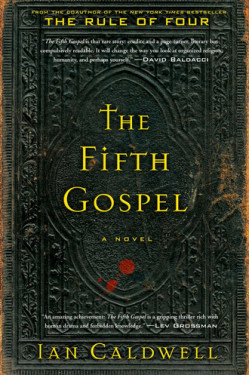 In a few months, I will be asking our readership to submit the names of books they will be reading this summer. I will be disappointed if Ian Caldwell’s “The Fifth Gospel” is not among the selections.
In a few months, I will be asking our readership to submit the names of books they will be reading this summer. I will be disappointed if Ian Caldwell’s “The Fifth Gospel” is not among the selections.
Published this week by Simon and Schuster, this mystery novel will remind the reader of “The DaVinci Code,” but ultimately it is less cynical of the Church and more about redemption and the human soul. But it’s also a great mystery story that involves deception, intrigue and murder, most of which takes place within the walls of Vatican City.
“The Fifth Gospel” is the story of two brothers, both priests, Father Simon Andreou, of the Latin Rite, and Father Alex Andreou, a married Eastern Rite priest. Ironically, it’s the Eastern Rite priest who lives inside the Vatican, while the Latin cleric serves in the Vatican’s Secretariat of State.
The two become involved in the planning of an exhibit of the Holy Shroud that is about to take place at the Vatican. But when the curator, Ugo Nagara, is found dead in the streets of Castel Gondolfo, one brother becomes a suspect and the other a victim of a break-in.
Much of the story revolves around the mystery of the Shroud and whether it is an authentic burial cloth of Jesus or a Medieval fake. To solve the puzzle, we are treated to a lot of background information about the Four Gospels and as well as a “Fifth” Gospel known as the Diatessaron and what they reveal about the Shroud.
There are also intricate theories about how the Shroud came from the East to the West and observations about the scientific studies that have been done on the holy cloth of Turin.
Obviously, the author has done lots of research, which accounts for the 10 years that it took to write the book. There’s plenty of background about the Church’s legal code, biblical scholarship and internal Vatican security that will fascinate even the more informed Catholic.
The book also has an ecumenical accent as relationships with the Roman Church and Eastern Orthodox are explored. The difference between the Bishop of Rome and the Eastern Patriarchs, the significance of 1054 and the Schism in Constantinople, and the Crusades and the Christian community at Edessa are all topics explored throughout the book.
The subplot about the married priest, his devotion to his young son and his estrangement from his wife, Mona, offers insight into the unique intricacies of a married priesthood.
Since this is a historical novel that takes place in 2004, Pope John Paul II, in the waning days of his papacy, becomes an important character toward the latter part of the story line.
Naturally, because it is fiction, the author is permitted to take some liberties with fact. For instance, the plot of the story has the Shroud moved from its safekeeping in Turin to the Vatican, which of course did not take place in real life. If you remember this is fiction – as so many forgot when reading “DaVinci” – you’ll be able to enjoy the writer’s rich imagination and the many twists as the mystery unfolds.
Ultimately, the book reveals its own impression about the historicity of the Shroud. It will not be revealed here, in order to preserve the ending of the writer’s story.
Caldwell is best known as the co-author of “The Rule of Four,” which spent 49 weeks on The New York Times best-sellers list. If you’re a fan of James Patterson or David Baldacci, you’ll love Caldwell’s latest work.
